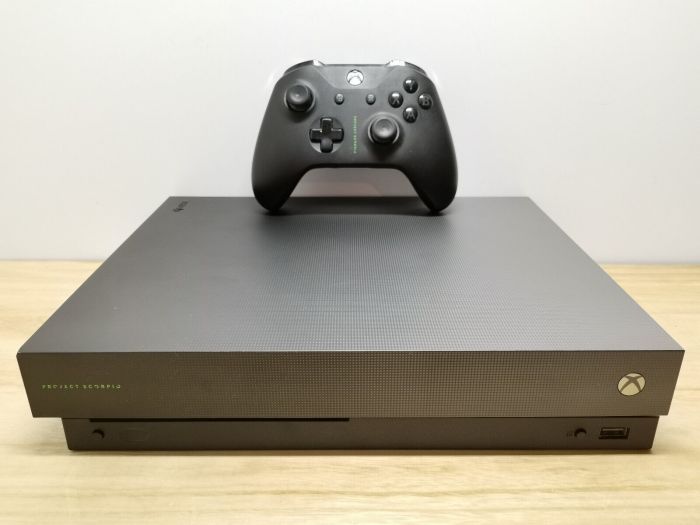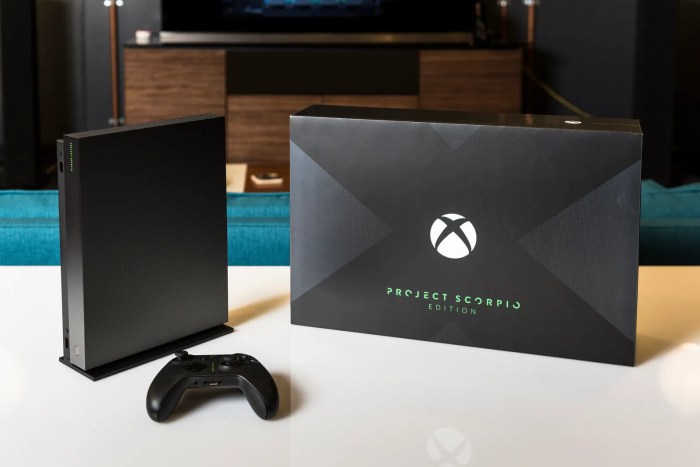Project Scorpio
Project Scorpio, later known as the Xbox One X, was a revolutionary step forward in the world of gaming consoles. It was a bold attempt by Microsoft to reclaim its position as the leader in console gaming, and it did so by prioritizing high-performance gaming and pushing the boundaries of what was possible on a home console.
The Origins and Goals
The origins of Project Scorpio can be traced back to Microsoft’s desire to deliver a truly next-generation gaming experience. They recognized that gamers were increasingly demanding higher resolutions, smoother frame rates, and more immersive graphics. The goal was to create a console capable of delivering native 4K gaming, a feat previously considered unattainable for home consoles.
Hardware Specifications
Project Scorpio was designed to be a powerhouse, and its hardware specifications reflected that ambition. It featured a custom-designed AMD processor, a powerful GPU capable of delivering 6 teraflops of performance, and 12GB of GDDR5 memory. This powerful combination of hardware allowed it to deliver native 4K resolution at 60 frames per second for many games.
Comparison with Previous Xbox Consoles
Project Scorpio represented a significant leap forward compared to its predecessors, the Xbox One and Xbox One S. The Xbox One X boasted significantly higher processing power, a more powerful GPU, and more memory, all of which contributed to its ability to deliver native 4K gaming. It was a clear demonstration of Microsoft’s commitment to pushing the boundaries of console gaming.
Native 4K Gaming
The gaming landscape is rapidly evolving, and one of the most significant advancements is the emergence of native 4K gaming. This technology promises to revolutionize the way we experience games, offering a level of visual fidelity that was once unimaginable.
The Significance of Native 4K Resolution
Native 4K resolution, with its 3840 x 2160 pixels, delivers an unparalleled level of detail and clarity, creating a truly immersive gaming experience. The increased pixel density translates to sharper textures, more realistic environments, and finer details that bring game worlds to life. Imagine seeing individual blades of grass in a vast meadow, or the intricate details of a character’s clothing. These are just a few examples of how native 4K resolution enhances the visual fidelity of games.
Technical Challenges of Achieving Native 4K Gaming
Achieving native 4K gaming presents significant technical challenges, primarily in terms of hardware requirements and software optimization. To render a game at 4K resolution, the graphics processing unit (GPU) needs to be powerful enough to handle the increased workload. This requires high-end graphics cards, often with multiple GPUs working in tandem. Additionally, game developers need to optimize their games to take advantage of the higher resolution, ensuring smooth frame rates and consistent performance.
Impact of Native 4K Gaming on the Gaming Experience
The impact of native 4K gaming on the overall gaming experience is undeniable. It elevates the visual quality to new heights, enhancing the immersion and realism of the virtual worlds. The sharper graphics and increased detail create a more captivating and engaging experience. However, the impact extends beyond aesthetics.
Native 4K gaming also has a significant impact on frame rates. Rendering a game at 4K resolution requires a more powerful GPU, which can sometimes lead to lower frame rates. This can affect the smoothness of gameplay, particularly in fast-paced action games. To mitigate this issue, game developers need to carefully optimize their games to ensure that they run smoothly at 4K resolution.
In conclusion, native 4K gaming is a significant advancement in the gaming industry, offering a level of visual fidelity that was once unimaginable. While technical challenges exist, the benefits in terms of visual clarity, immersion, and gameplay are undeniable. As technology continues to evolve, we can expect to see native 4K gaming become increasingly prevalent, ushering in a new era of gaming experiences.
Microsoft Games: Project Scorpio Run Microsoft Games Native 4k
Project Scorpio, with its powerful hardware, was designed to deliver a truly immersive gaming experience, and one of the key features was its ability to support native 4K resolution. Microsoft, being the platform holder, had a vested interest in showcasing the capabilities of their console and did so by releasing several of their own first-party titles that were optimized for 4K. These games were not just simple upscales, but were meticulously designed to take advantage of the extra processing power available, resulting in breathtaking visuals and a level of detail previously unseen on consoles.
Games Supporting Native 4K Resolution
Microsoft Studios and Xbox Game Studios have released several games that support native 4K resolution on Project Scorpio. These games showcase the console’s capabilities and offer a visually stunning experience for players.
- Forza Horizon 4: The open-world racing game features stunning environments, detailed car models, and a high level of visual fidelity, all rendered in native 4K. The game also supports HDR, which enhances the overall visual experience.
- Gears of War 4: This third-person shooter features a gritty and realistic aesthetic, with detailed environments and character models. The game runs at a smooth 60 frames per second in native 4K, delivering a fluid and immersive gameplay experience.
- Halo 5: Guardians: The sci-fi shooter is a visually impressive game, with detailed environments, impressive lighting effects, and a high level of detail. The game runs at a smooth 60 frames per second in native 4K, providing a fast-paced and responsive gameplay experience.
- Sea of Thieves: The open-world pirate adventure game features a vibrant and colorful world, with detailed environments and character models. The game runs at a smooth 60 frames per second in native 4K, delivering a fluid and immersive gameplay experience.
- State of Decay 2: This open-world zombie survival game features a large and detailed world, with a focus on realistic graphics and environments. The game runs at a smooth 60 frames per second in native 4K, providing a challenging and immersive gameplay experience.
Graphical Enhancements and Features
These games utilize various graphical enhancements and features to take full advantage of the 4K resolution and the powerful hardware of Project Scorpio. These enhancements contribute to the overall visual fidelity and immersive experience of the games.
- High-resolution textures: Games like Forza Horizon 4 and Gears of War 4 feature significantly higher resolution textures compared to their standard resolution counterparts. This results in more detailed environments, objects, and character models, creating a more realistic and immersive experience.
- Improved lighting and shadow effects: Games like Halo 5: Guardians and Sea of Thieves utilize advanced lighting and shadow techniques, resulting in more realistic and atmospheric environments. These effects create a sense of depth and realism, enhancing the overall visual experience.
- Enhanced anti-aliasing: Games like State of Decay 2 and Forza Horizon 4 implement advanced anti-aliasing techniques to smooth out jagged edges and create a cleaner and more polished visual experience. This results in a more realistic and immersive experience, particularly in environments with high levels of detail.
- Higher draw distances: Games like Forza Horizon 4 and Sea of Thieves feature significantly increased draw distances, allowing players to see further into the distance. This creates a more expansive and immersive world, enhancing the overall gameplay experience.
Performance Impact of Native 4K
While native 4K resolution offers a significant visual upgrade, it also demands more processing power from the console. The impact on performance can vary depending on the specific game and its optimization.
- Frame rates: Most of the games mentioned above run at a smooth 60 frames per second in native 4K. However, some games, like State of Decay 2, may experience occasional dips in frame rate in more demanding scenes. These dips are typically minor and do not significantly impact the overall gameplay experience.
- Loading times: Native 4K resolution can sometimes lead to slightly longer loading times, as the console needs to process more data. However, the impact is generally minimal and does not significantly affect the overall gameplay experience.
- Overall smoothness of gameplay: While native 4K resolution can sometimes impact frame rates, the overall smoothness of gameplay is generally not affected. The games mentioned above maintain a high level of responsiveness and fluidity, even in native 4K.
The Future of Gaming
The advent of native 4K gaming has ushered in a new era of visual fidelity and immersion, but it’s only the beginning. The future of gaming promises even more breathtaking experiences, with advancements in technology and a growing demand for higher-resolution visuals.
The Rise of Native 4K Gaming
The adoption of native 4K gaming is poised to accelerate across various platforms and genres. As hardware becomes more powerful and affordable, more developers will embrace the 4K resolution, delivering stunningly detailed worlds and immersive gameplay. Consoles like the Xbox Series X and PlayStation 5 have already paved the way, demonstrating the capabilities of native 4K gaming. PC gaming is also embracing 4K, with high-end graphics cards becoming increasingly accessible.
The Impact of Emerging Technologies, Project scorpio run microsoft games native 4k
Emerging technologies like ray tracing and HDR are set to revolutionize the 4K gaming experience. Ray tracing simulates the behavior of light, creating more realistic reflections, shadows, and lighting effects. This technology adds a level of depth and realism that was previously unimaginable. HDR, or High Dynamic Range, expands the range of colors and contrasts, resulting in a more vibrant and immersive visual experience. These technologies will work together to create a truly stunning 4K gaming experience.
Project Scorpio’s Legacy
Project Scorpio, now known as the Xbox Series X, was a groundbreaking console that pushed the boundaries of high-performance gaming. It demonstrated Microsoft’s commitment to delivering native 4K gaming experiences. The console’s success has paved the way for future generations of consoles and gaming PCs, further solidifying the importance of 4K gaming. Project Scorpio’s legacy will continue to shape the future of gaming, driving innovation and pushing the limits of what’s possible.
Project scorpio run microsoft games native 4k – Project Scorpio’s legacy extends far beyond its technical specifications. It represents a turning point in the evolution of gaming, a bold statement that Microsoft was committed to pushing the boundaries of what was possible. The Xbox One X, with its native 4K capabilities, paved the way for a future where visual fidelity is no longer a compromise, but a standard. It set a benchmark for future consoles and inspired developers to create games that truly took advantage of the power of native 4K. As we look to the future of gaming, the impact of Project Scorpio, the Xbox One X, and its native 4K prowess is undeniable.
Project Scorpio, later rebranded as Xbox One X, promised a revolutionary gaming experience with native 4K resolution for Microsoft games. This powerful console was a marvel of engineering, pushing the boundaries of what was possible for home gaming. It was a far cry from the HTC Nexus Sailfish Snapdragon 821 , a phone released around the same time, which focused on a sleek design and a high-performance processor.
But both devices were testaments to the constant evolution of technology and the ever-increasing demand for immersive experiences.
 Standi Techno News
Standi Techno News

